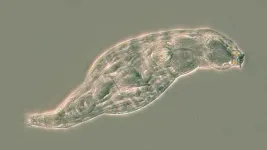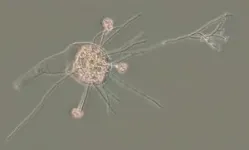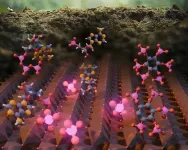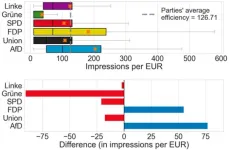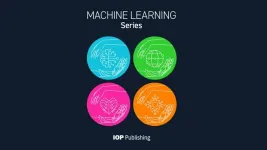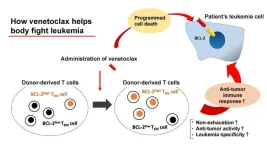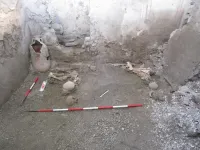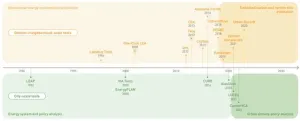(Press-News.org) WOODS HOLE, Mass. -- A group of small, freshwater animals protect themselves from infections using antibiotic recipes “stolen” from bacteria, according to new research by a team from the University of Oxford, the University of Stirling and the Marine Biological Laboratory (MBL), Woods Hole.
The tiny creatures are called bdelloid rotifers, which means ‘crawling wheel-animals’. They have a head, mouth, gut, muscles and nerves like other animals, though they are smaller than a hair’s breadth.
When these rotifers are exposed to fungal infection, the study found, they switch on hundreds of genes that they acquired from bacteria and other microbes. Some of these genes produce resistance weapons, such as antibiotics and other antimicrobial agents, in the rotifers. The team reports its findings this week in Nature Communications.
“When we translated the DNA code to see what the stolen genes were doing, we had a surprise,” said lead study author Chris Wilson of University of Oxford. “The main genes were instructions for chemicals that we didn’t think animals could make — they looked like recipes for antibiotics.”
Prior research found that rotifers have been picking up DNA from their surroundings for millions of years, but the new study is the first to discover them using these genes against diseases. No other animals are known to “steal” genes from microbes on such a large scale.
“These complex genes – some of which aren’t found in any other animals – were acquired from bacteria but have undergone evolution in rotifers,” said study co-author David Mark Welch, senior scientist and director of the Josephine Bay Paul Center at the Marine Biological Laboratory. “This raises the potential that rotifers are producing novel antimicrobials that may be less toxic to animals, including humans, than those we develop from bacteria and fungi.”
Recipes for self-defense
Antibiotics are essential to modern healthcare, but most of them were not invented by scientists. Instead, they are produced naturally by fungi and bacteria in the wild, and humans can make artificial versions to use as medicine.
The new study suggests that rotifers might be doing something similar.
“These strange little animals have copied the DNA that tells microbes how to make antibiotics,” explains Wilson. “We watched them using one of these genes against a disease caused by a fungus, and the animals that survived the infection were producing 10 times more of the chemical recipe than the ones that died, indicating that it helps to suppress the disease.”
The scientists think that rotifers could give important clues in the hunt for drugs to treat human infections caused by bacteria or fungi.
Antibiotics are becoming less effective because the disease-causing microbes have evolved to become resistant and no longer respond to treatment. The World Health Organization recently sounded the alarm, warning in a June report of the “pressing need” to develop new antibiotics to counter the threat of resistance.
“The recipes the rotifers are using look different from known genes in microbes,” said study author Reuben Nowell of the University of Stirling. “They’re just as long and complicated, but parts of the DNA code have changed. We think the recipe has been altered by a process of evolution to make new and different chemicals in the rotifers. That’s exciting because it might suggest ideas for future medicines.”
The genes the rotifers acquired from bacteria encode an unusual class of enzymes that assemble amino acids into small molecules called non-ribosomal peptides.
“The next phase of this research should involve identification of multiple non-ribosomally synthesized peptides produced by bdelloid rotifers, and establishment of the conditions upon which the synthesis of these compounds can be induced,” said study co-author Irina Arkhipova, senior scientist at the Marine Biological Laboratory.
One problem with developing new drugs is that many antibiotic chemicals made by bacteria and fungi are poisonous or have side-effects in animals. Only a few can be turned into treatments that clear harmful microbes from the human body.
If rotifers are already making similar chemicals in their own cells, they could lead the way to drugs that are safer to use in other animals, including people.
Why do rotifers acquire so many foreign genes?
A big question is why rotifers are the only animals that borrow these useful genes from microbes at such high rates.
“We think it might be linked with another strange fact about these rotifers,” said Tim Barraclough, a study co-author from the University of Oxford. “Unlike other animals, we never see male rotifers. Rotifer mothers lay eggs that hatch into genetic copies of themselves, without needing sex or fertilization.”
According to one theory, animals that copy themselves like this can become so similar that it starts to be unhealthy. “If one catches a disease, so will the rest,” explained Barraclough. Because bdelloid rotifers don’t have sex, which allows the parental genes to recombine in beneficial ways, the rotifer mother’s genome is directly transferred to her offspring without introducing any new variation.
“If rotifers don’t find a way to change their genes, they could go extinct. This might help explain why these rotifers have borrowed so many genes from other places, especially anything that helps them cope with infections,” said Barraclough.
Nowell thinks there is much more to learn from rotifers and their stolen DNA “The rotifers were using hundreds of genes that aren’t seen in other animals. The antibiotic recipes are exciting, and some other genes even look like they’ve been taken from plants. The findings are part of a growing story about how and why genes get moved between different kinds of life,” he said.
###
The Marine Biological Laboratory (MBL) is dedicated to scientific discovery – exploring fundamental biology, understanding marine biodiversity and the environment, and informing the human condition through research and education. Founded in Woods Hole, Massachusetts in 1888, the MBL is a private, nonprofit institution and an affiliate of the University of Chicago.
END
Small animals acquire genes from bacteria that can produce antibiotics
2024-07-18
ELSE PRESS RELEASES FROM THIS DATE:
Unexpected role of OTX2 drives aggressive medulloblastoma
2024-07-18
In a report published in Nature Cell Biology, researchers at Baylor College of Medicine, Texas Children’s Hospital, the University of Manitoba and collaborating institutions revealed an unexpected way in which the protein OTX2 drives the progression of medulloblastoma – the most common aggressive childhood brain cancer. The findings suggest that targeting OTX2 or its effects can have therapeutic relevance.
“We see medulloblastoma stem cells as the root of the disease. The tumors develop from these cells early during development of the cerebellum, the brain region ...
Study shows new efficiency standards for heavy trucks could boost energy use
2024-07-18
Deliveries are getting faster than ever in the U.S., but the faster movement of goods is undercutting the country’s climate progress.
In a new study published July 18 in the journal Nature Energy, a CU Boulder researcher and his collaborator estimate that federal regulations aimed at enhancing heavy-duty trucks’ energy efficiency could be as much as 20% less effective than policymakers initially anticipated.
That’s because the regulations make trucking cheaper. As a result, more shippers will likely switch from using less energy-intensive rail transportation to using more energy-intensive trucks to ship goods.
“We ...
Minerals play newly discovered role in Earth’s phosphorus cycle
2024-07-18
Northwestern University-led researchers have discovered a new way that nature cycles phosphorus, a finding that uncovers a missing piece of Earth’s puzzling phosphorus cycle.
The research will be published on Thursday (July 18) in the journal Nature Communications.
A critical nutrient for plant growth, phosphorus is a non-negotiable component of fertilizers. Without it, farmers cannot ensure plant health and boost crop yields. Understanding Earth’s phosphorus cycle, therefore, is important for protecting the global food supply.
Although ...
Social media: How algorithms influence election campaigns
2024-07-18
Milano, 18 luglio 2024 – A new study published in the journal PNAS Nexus reveals how social media algorithms favor politically sponsored content from certain parties given the same investment budget.
The research, a collaboration between the Politecnico di Milano, LMU – Ludwig Maximilians Universität of Munich, and the CENTAI institute of Turin, analyzed over 80,000 political ads on Facebook and Instagram before the 2021 German federal elections. These ads were placed by parties across the political spectrum and generated over 1.1 billion impressions during an election with more than 60 million eligible voters.
Investigating ...
IOP Publishing launches series of open access journals dedicated to machine learning and artificial intelligence for the sciences
2024-07-18
IOP Publishing (IOPP) is launching the world’s first series of open access journals dedicated to the application and development of machine learning (ML) and artificial intelligence (AI) for the sciences. The new multidisciplinary Machine Learning series will collectively cover applications of ML and AI across the physical sciences, engineering, biomedicine and health, and environmental and earth science.
Building on the successful launch of Machine Learning: Science and Technology in 2019, IOPP’s Machine Learning series will expand to include three new ...
Research shows young infants use their mother’s scent to see faces
2024-07-18
Humans see the world through the five senses, but how and when the ability to integrate across the senses arises is debated. Research shows that humans combine sensory information together, particularly when one sense is not able to produce a sufficient response alone. Studies also show that infants may use multisensory cues to perceive their environments more efficiently. A new Child Development study by researchers at the Université de Bourgogne, University of Hamburg, Université de Lyon, Institut Universitaire de France, Université de Lorraine, Centre Hospitalier de Nancy, and Centre National de la Recherche Scientifique ...
Novel drug application shows improved survival for patients with relapsed and refractory acute myeloid leukemia
2024-07-18
Relapsed/refractory acute myeloid leukemia (AML), a so-called blood cancer, has an extremely poor prognosis because of resistance to anti-cancer drugs and frailty of the patient’s organ functions. A type of anti-tumor immunotherapy called allogeneic hematopoietic cell transplantation, which can exert anti-cancer effect accompanied by severe toxicity, is often performed for patients who are hard to treat with chemotherapy, but relapse still remains.
The hematopoietic cell transplant team in ...
Pompeii skeleton discovery shows another natural disaster may have made Vesuvius eruption even more deadly
2024-07-18
Almost 2,000 years ago, Pliny the Younger wrote letters describing a shaking ground as Vesuvius erupted. Now, a collaborative study led by researchers from the Istituto Nazionale di Geofisica e Vulcanologia (INGV) and Pompeii Archaeological Park has shed light on the effects of seismicity associated with the 79CE eruption.
The study is the first to tackle the complex task of reporting on the effects of co-occurring earthquakes. This is tricky due to the possibility of volcanic and seismic effects happening concurrently or in quick succession, meaning volcanic effects can overshadow effects caused by earthquakes and vice versa.
“These ...
Egg freezing: Britain’s largest ever study reports live birth outcomes comparable to those of routine IVF
2024-07-18
18 July 2024: Britain’s largest ever study of egg freezing which followed up the outcome of almost 30,000 eggs frozen at the London Women’s Clinic shows that success rates are comparable to those achieved by routine IVF and subject to the same variables of female age and embryo quality.(1) When seen alongside other similar large-scale egg-freezing studies from other countries, the results of this study add to a pattern of success which is consistent, predictable and reliable.
The study, published today in the peer-reviewed journal Reproductive Biomedicine Online, analysed the outcomes of treatment ...
Assessment methods for realizing digital urban planning and low-carbon urban design
2024-07-18
With the promotion of carbon neutrality and carbon peaking goals, the construction of low-carbon cities and related quantitative assessments have become hot topics in the field of urban planning and design. The Intergovernmental Panel on Climate Change (IPCC) points out that the net emissions of anthropogenic greenhouse gases have continued to rise over the past decade, with the average annual emissions higher than any previous decade. Without additional climate change mitigation policies, global warming could lead to a temperature increase of 3.5°C ...
